
Cunninghamhead Estate
Encyclopedia
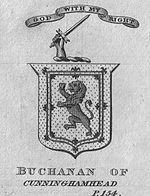
Irvine, North Ayrshire
Irvine is a new town on the coast of the Firth of Clyde in North Ayrshire, Scotland. According to 2007 population estimates, the town is home to 39,527 inhabitants, making it the biggest settlement in North Ayrshire....
, Scotland
Scotland
Scotland is a country that is part of the United Kingdom. Occupying the northern third of the island of Great Britain, it shares a border with England to the south and is bounded by the North Sea to the east, the Atlantic Ocean to the north and west, and the North Channel and Irish Sea to the...
. It was once a private estate, owned by a sequence of recorded families since around 1418. The Mansion
Mansion
A mansion is a very large dwelling house. U.S. real estate brokers define a mansion as a dwelling of over . A traditional European mansion was defined as a house which contained a ballroom and tens of bedrooms...
House, one of Britain's lost houses
Destruction of country houses in 20th-century Britain
The destruction of country houses in 20th-century Britain was a phenomenon brought about by a change in social conditions during which a large number of country houses of varying architectural merit were demolished...
, was built in 1747; it was destroyed by fire in the early 1960s, whilst renovation work was being carried out. The old mansion and castle have been lost, however the stables are still a residence, whilst the Gardner's Cottage survive as ruins. From 1964, work was carried out, first to use the estate as a chicken farm and later as holiday and residential, caravan park and camping site, making most of the rural location. Circa 2003 the site was significantly redeveloped to become a residential caravan park exclusively for the use of retired and semi-retired persons.
The history of the Cunninghamhead Estate
The previous name of the area was Woodhead, the name change to Cunninghamhead taking place before 1418; a charter dated 1346 from King David IIDavid II of Scotland
David II was King of Scots from 7 June 1329 until his death.-Early life:...
to Godfrey de Ross refers to him as being 'of Coyninghamheid'. Gordon's map of 1654 shows 'Cuningham Head' and 'Rungham' is marked on Moll's 1745 map. Cunninghamhead Castle was a square tower, referred to as a "strong old donjon" by Pont and demolished by John Snodgrass in 1747 when a mansion house was built. The original meaning of the term 'donjon' referred to the mound or motte, not the dungeons. The estate had cost John Snodgrass Buchanan the sum of £23,309 and 2d Scots when he purchased them on 23 January 1728.
At the time of its construction Cunninghamhead House was held to be amongst the most elegant in the country, however by Robertson's time (1823) it had been altered and had lost much of its previous elegance. William Aitons's Ayrshire map of 1811 shows the new mansion and the ruins of the castle behind.
The Cunninghame family held these lands for several centuries before the Snodgrass family purchased them. In 1823 the Buchanans of Craigievairn held the estate; Mr. Snodgrass Buchanan was the owner in 1838. The Kerr's followed them in turn and the 1951 Statistical Account records the Misses Kerr as owning the estate. Middleton had been part of the estate. In around 1564 the name is given as 'Cunnygahamehead' and the laird also held Powkellie, now Pokelly
Polkelly Castle
Polkelly Castle, also Pokelly was an ancient castle located near Fenwick, at NS 4568 4524, in the medieval free Barony of Polkelly, lying north of Kilmarnock, Parish of Fenwick, East Ayrshire, Scotland. The castle is recorded as Powkelly , Pockelly , Pow-Kaillie, Ponekell, Polnekel, Pollockelly,...
, near Stewarton
Stewarton
Stewarton is a town in East Ayrshire, Scotland. In comparison to the neighbouring towns of Kilmaurs, Fenwick, Dunlop and Lugton, it is a relatively large town, with a population of over 6,500. It is 300 feet above sea level.Groome, Francis H. . Ordnance Gazetteer of Scotland. Pub. Caxton. London....
.

Dalry, North Ayrshire
Dalry is a small town in the Garnock Valley in Ayrshire, Scotland.-History:Dalry means "King's Valley" or more simply the "Rye Meadow"; indicating a small settlement on the Rye Burn. Its history has signs of early inhabitants in the area...
, set the Devil to build a road across Kinnicumhead Moss in a single night. This links to the original pronunciation of Cunninghame being closer to 'Kinikam'
Lambroughton
Lambroughton is a village in the old Barony of Kilmaurs, North Ayrshire, Scotland. This is a rural area famous for its milk and cheese production and the Ayrshire or Dunlop breed of cattle.-Origins of the name:...
.
Sir William and Sir John Cunninghame
Of the many genereations of the Cunninghame family who lived at Cunninghamehead, Sir William and his brother Sir John are recorded as pre-eminent. Sir William was present in the Great Parliament of 1560 and as a great supporter of John Knox's reforms which saw the "end of popery" in Scotland as the de facto state religion. Sir John was a member of the General Assembly in 1565 which was "so obnoxious to the those of the old religion at that time"'.The Highland Hosts
In the 1640s Alasdair Mac Colla had been sent by MontroseJames Graham, 1st Marquess of Montrose
James Graham, 1st Marquess of Montrose was a Scottish nobleman and soldier, who initially joined the Covenanters in the Wars of the Three Kingdoms, but subsequently supported King Charles I as the English Civil War developed...
to suppress support for the Covenanting cause. He plundered the Ayrshire countryside for some days and then demanded financial penalties. Sir William Cunningham's penalty for Cunninghamhead was 1,200 merks; £10,000 worth of damage already having been done.
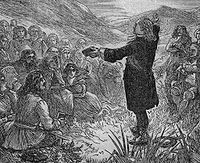
Gaels
The Gaels or Goidels are speakers of one of the Goidelic Celtic languages: Irish, Scottish Gaelic, and Manx. Goidelic speech originated in Ireland and subsequently spread to western and northern Scotland and the Isle of Man....
, was brought into Ayrshire in 1678 by the Crown Authorities to prevent the conventicles
Conventicle Act 1664
The Conventicle Act of 1664 was an Act of the Parliament of England that forbade conventicles...
or public meetings held by the Presbyterians. At Cunninghamhead, occupied at this time by Sir William Cunninghame, Highlanders lived at 'heck and manger' for a month; what meal was in the granary they could not eat, they destroyed; they used fire to open lockfast places; and the Colonel of the troop threatened a farmer upon whom he had quartered himself that, if he did not hand over his money, he would hang him in his own barn.
Robertson relates that "They took free quarters; they robbed people on the high road; they knocked down and wounded those who complained; they stole, and wantonly destroyed, cattle; they subjected people to the torture of fire to discover to them where their money was hidden; they threatened to burn down houses if their demands were not at once complied with; besides free quarters they demanded money every day; they compelled even poor families to buy brandy and tobacco for them; they cut and wounded people from sheer devilment." The cost of all this amounted to £1,505 17s 0d. in Dreghorn and Pearceton (Sic) parish alone.
The residence of the Snodgrass family
John Snodgrass acquired the estate in 1728 and in 1747 pulled down the old tower-house and constructed the mansion. Neil Snodgrass nbuilt the stables and extended or rebuilt the mansion house. Neil Snodgrass in 1755 had been bound as apprentice to study law, however he had his sight much injured by smallpoxSmallpox
Smallpox was an infectious disease unique to humans, caused by either of two virus variants, Variola major and Variola minor. The disease is also known by the Latin names Variola or Variola vera, which is a derivative of the Latin varius, meaning "spotted", or varus, meaning "pimple"...
and was compelled to return to the country and devote himself to country pursuits. He became a great friend of Alexander, Earl of Eglinton
Earl of Eglinton
Earl of Eglinton is a title in the Peerage of Scotland.Some authorities spell the title: Earl of Eglintoun In 1859 the thirteenth Earl of Eglinton, Archibald Montgomerie, was also created Earl of Winton in the Peerage of the United Kingdom, which gave him an automatic seat in the House of Lords,...
and joined him in his pursuit of practical improvements in agriculture, such as crop rotations and fallow years. In 1773 he married Marian, daughter of James McNeil Esq. of Kilmorie. They had six children.
Aiton complimented Mr. Snowgrass, actually Snodgrass, for his zeal in pursuing agricultural improvements in 1811, following the example set by the Earls of Eglinton and Loudoun amongst others. The arms of the Snodgrass family were a figure of justice, suspending a balance; Motto, - Discite Justinian.The Lands of Cunninghamhead were valued at £330 in 1640. William Kerr Esq of Cunninghamhead was buried in Dreghorn
Dreghorn
Dreghorn is a village near Irvine, North Ayrshire, Scotland. This parish comprehends the old parishes of Dreghorn and Pearston, which were united in 1668. The whole of the parish was historically the property of the De Morvilles, who were Constables of Scotland and Lords of Cunninghame...
Parish churchyard.
Mr and Miss Buchanan of Cunninghamhead attended the famous 1839 Eglinton Tournament in what is now Eglinton Country Park
Eglinton Country Park
Eglinton Country Park is located in the grounds of the old Eglinton Castle estate, Kilwinning, North Ayrshire, Scotland . Eglinton Park is situated in the parish of Kilwinning, part of the former district of Cunninghame, and covers an area of 400 hectares...
and were alloted a seat in the Grand Stand.
The Kerr family
Hugh Kerr of Gatend Farm near BarrmillBarrmill
Barrmill is a small village in North Ayrshire, Scotland about a mile and a half a mile east of Beith on the road to Lugton. Locally it is known as the Barr.- History :General Roy's survey of 1747 - 55 shows only the farm of High Barr...
died on 9th August, 1818 and his wife died on the 19th. Hugh had three of the sons, William, Robert and Hugh who emigrated to America and became very wealthy. William Kerr purchased Cuninghamehead, and resided here upon his retirement until his death in 1853. He was succeeded by an only child, Richard, who succeeded him.
The Mansion House
The dilapidated mansion house was purchased by a developer after the death of the Kerr sisters and the renovations were nearly complete when vandals broke in and the building was destroyed by fire. The fire was in the early 1960s and the as the house was too badly damaged for restoration it was demolished.The estate became significantly run down, the main entrance road impassable even by foot. From 1964, works were carried to first use the estate as a chicken farm and later as a caravan park and camping site. From 2003 onwards significant redevelopment of the caravan park and camping site was carried out to create a residential caravan park exclusively for the retired and semi-retired.
The Cottage Ornee
An unusual building of some antiquity stands as a substantial ruin beside the river Annick Water in the holm on the southern bank. A road through the woods connects the site to the stables and to the location of the old Mansion House. This building's remains are constructed of sizeable river boulders as foundations and well worked and carved freestone or sandstone ashlar blocks. It had a large window and door facing onto the holm, whilst the wall facing the river has largely collapsed and may have had two large windows. The door has been carefully blocked and the 'holm' facing window may have been made into an entrance.The relatively small size of the structure may suggest a social purpose, such as a type of 'Summer House' or 'Cottage orne' from the early development of the estate, circa 1747. Its last occupant was a Mackay, who was a poet
Poet
A poet is a person who writes poetry. A poet's work can be literal, meaning that his work is derived from a specific event, or metaphorical, meaning that his work can take on many meanings and forms. Poets have existed since antiquity, in nearly all languages, and have produced works that vary...
or writer
Writer
A writer is a person who produces literature, such as novels, short stories, plays, screenplays, poetry, or other literary art. Skilled writers are able to use language to portray ideas and images....
. A Charles Mackay was editor of the Glasgow Argus for four years from 1844, contributing articles and poetry to the Daily News. He returned to London and joined the London Illustrated News. Another more obscure Charles Mackay, an actor and writer, belongs to the early 18th. century.
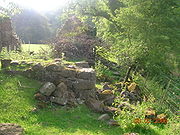

The Gardener's Cottage
The Gardener's Cottage lies at the bottom of the road to the river. The building was of substantial size, having been extended at least once during it's history. Following persistent vandalism it was demolished in the mid 1980s.The Stables
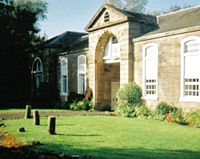
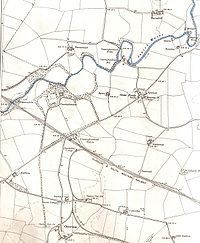
A small doocot or dovecot
Dovecote
A dovecote or dovecot is a structure intended to house pigeons or doves. Dovecotes may be square or circular free-standing structures or built into the end of a house or barn. They generally contain pigeonholes for the birds to nest. Pigeons and doves were an important food source historically in...
was above the entrance arch. This was a feature of many estates, as the right to build a doocot was originally strictly limited to the major landowners, and only later were small freeholders permitted to build them; at a more recent date tenants could sometimes gain permission from their landlord to build doocots for the meat or to add a picturesque feature to their properties.
Other estate structures
Ruins of other vernacular buildings, known as the 'Gardener's Cottage' are also to be found as total ruins in the woods off to the left hand side of the path leading down to the Annick Water from the estate. Quarry Holm, beside the old railway embankment between the estate and Annick Lodge, has the foundations of some old buildings, industrial in nature, which appear to have seen re-use before being abandoned. The railway line of 1843 cut off this site from the Annick Lodge area.The natural history of the estate
Sections of the deciduous woods on the northern side of the Annick Water from the old mansion house have a rich plant diversity, indicating that they are long established and not just plantations on previously cleared land. These woodlands contain plants such as Male Shield Fern, Lady Fern, Tuberous Comfrey, Tussock Grass, BluebellsCommon Bluebell
Hyacinthoides non-scripta, commonly known as the common bluebell, is a spring-flowering bulbous perennial plant. -Taxonomy:...
, Dog's Mercury
Dog's Mercury
Mercurialis perennis, commonly known as dog's mercury, is a woodland plant found in much of Europe, but almost absent from Ireland, Orkney and Shetland. A member of the spurge family , it is a herbaceous, downy perennial with erect stems bearing simple, serrate leaves. The dioecious inflorescences...
, Opposite-Leaved Golden Saxifrage, Woodrush, Sanicle, Enchanter's Nightshade and Wood Sorrel. Agrimony
Agrimony
Agrimonia, commonly known as Agrimony, is a genus of 12-15 species of perennial herbaceous flowering plants in the family Rosaceae, native to the temperate regions of the Northern Hemisphere, with one species also in Africa...
is another unusual find, growing in a riparian position on the Annick Water bank, together with wild Mint, just upstream of the old railway viaduct.
See also
- CunninghamheadCunninghamheadCunninghamhead is a hamlet in North Ayrshire, Scotland. It was the centre of the lands of Cunninghamhead, Perceton and Annick Lodge in Cunninghame...
- LambroughtonLambroughtonLambroughton is a village in the old Barony of Kilmaurs, North Ayrshire, Scotland. This is a rural area famous for its milk and cheese production and the Ayrshire or Dunlop breed of cattle.-Origins of the name:...
- ChapeltounChapeltounChapeltoun is an estate on the banks of the Annick Water in East Ayrshire, Scotland. This is a rural area famous for its milk and cheese production and the Ayrshire or Dunlop breed of cattle.-Templeton and the Knights Templar:...
- Corsehill
- Staddle stonesStaddle stonesStaddle stones were originally used as supporting bases for granaries, hayricks, game larders, etc. The staddle stones lifted the granaries above the ground thereby protecting the stored grain from vermin and water seepage...
- The History of Cunninghamhead
- Cunninghamhead railway stationCunninghamhead railway stationCunninghamhead railway station was a railway station serving Cunninghamhead Estate, the village of Crossroads , North Ayrshire and the town of Stewarton, East Ayrshire, Scotland...
- Auchenharvie CastleAuchenharvie CastleAuchenharvie Castle is a ruined castle near Torranyard on the A 736 Glasgow to Irvine road. It lies in North Ayrshire, Scotland.-The Castle:...
- Thorntoun Estate
- LugtonLugtonLugton is a small village or hamlet in East Ayrshire, Scotland with a population of 80 people. The A736 road runs through on its way from Glasgow, to the north, to Irvine in North Ayrshire. Uplawmoor is the first settlement on this 'Lochlibo Road' to the north and Burnhouse is to the south...
- The Caldwell estate. - Eglinton Country ParkEglinton Country ParkEglinton Country Park is located in the grounds of the old Eglinton Castle estate, Kilwinning, North Ayrshire, Scotland . Eglinton Park is situated in the parish of Kilwinning, part of the former district of Cunninghame, and covers an area of 400 hectares...

